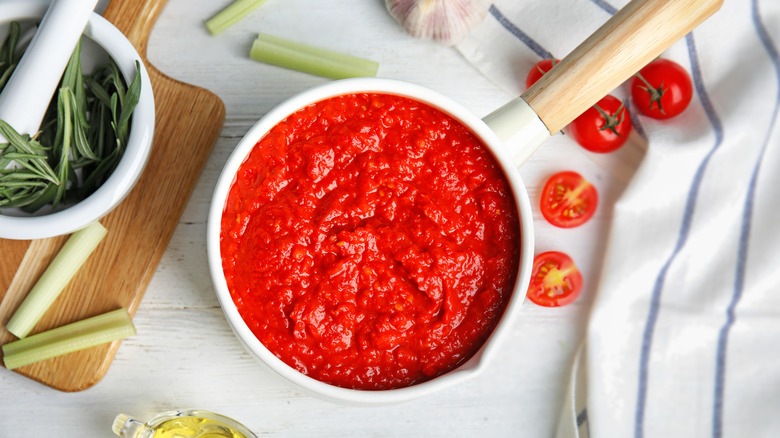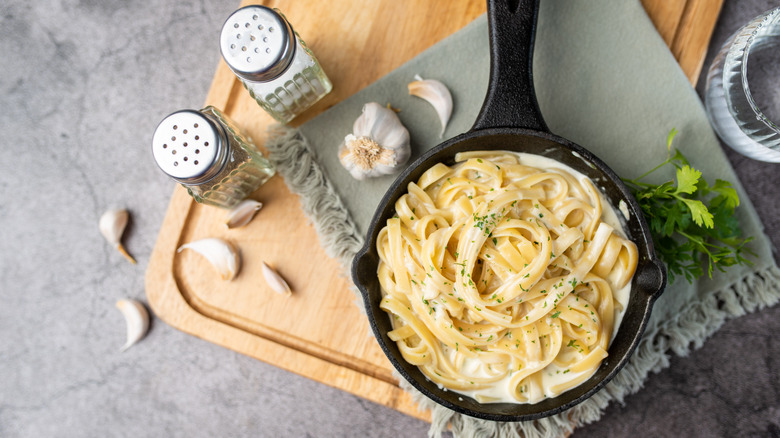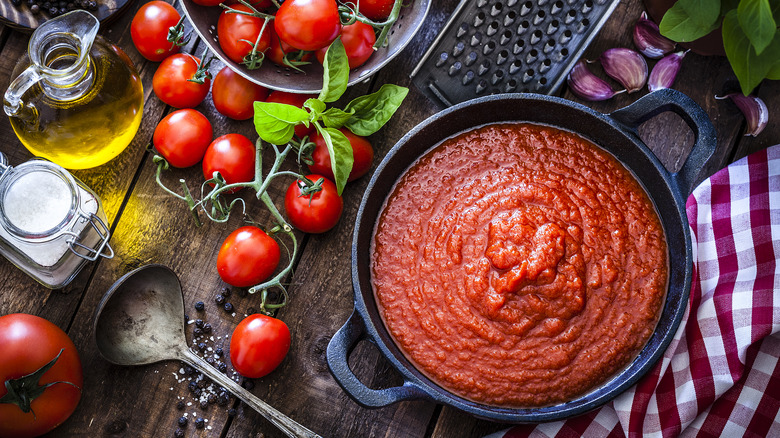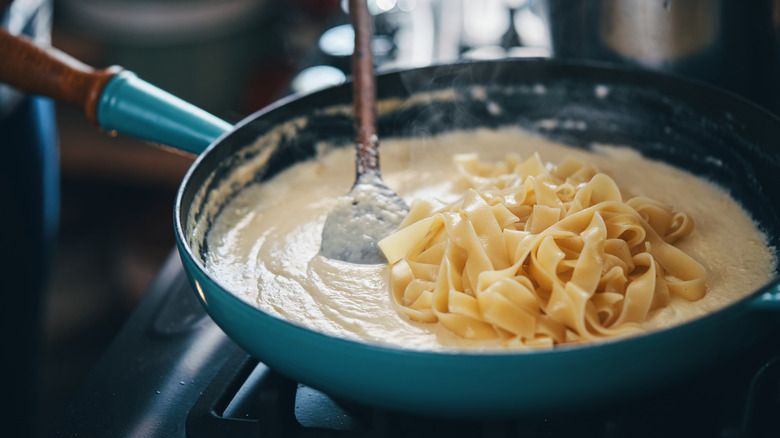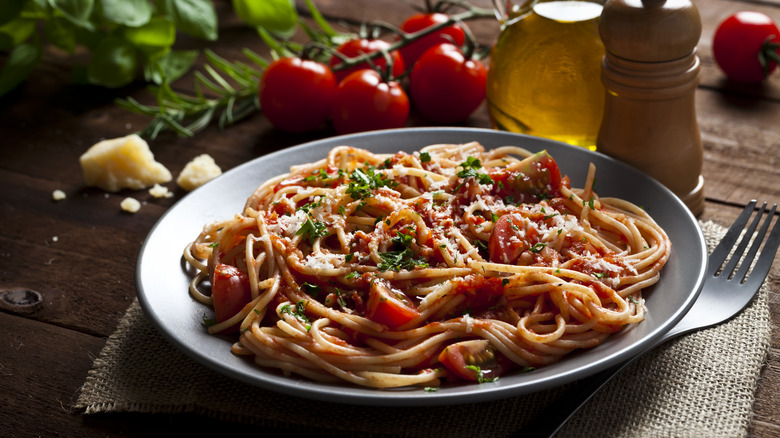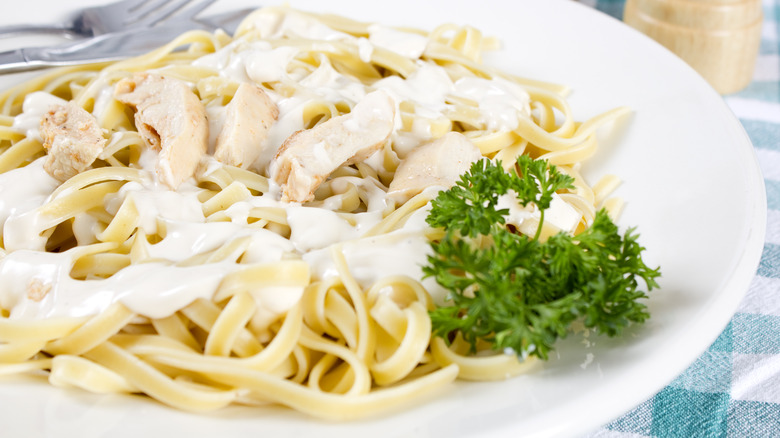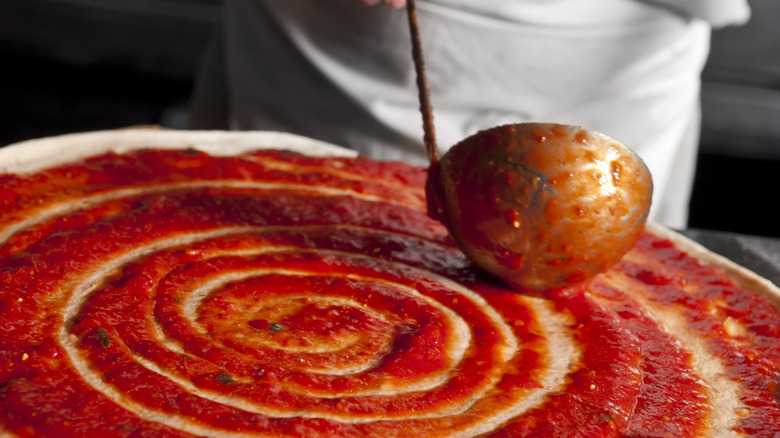Marinara Vs Alfredo Sauce: What You Need To Know
When it comes to pasta sauce, you have a lot of options. Some of them, like ragù and Bolognese, might be kind of difficult to tell apart, but others, like marinara and Alfredo sauce, are two totally different (and two totally delicious) things.
Both marinara and Alfredo sauce have their own unique flavors, textures, and dedicated dishes, making it easy to distinguish one from the other. The only two things they really have in common are that they're both pasta sauces and that neither is really considered "Italian" in Italy.
In the U.S., marinara sauce is a simple tomato sauce made with herbs, but in Italy it is flavored with capers and fish like dried, salted anchovies ("marinara" roughly translates to "seafaring" or "sailor" in Italian). And anyone who asks for a plate of buttery, creamy fettuccine Alfredo in Italy will be met with confused looks from their waiter or host, as this dish doesn't really exist there — something this Italian cuisine-loving American writer had to learn the hard way when she moved there.
But whether they are truly Italian or not, these two sauces always make for a great plate of pasta. Let's get to know each of them a bit better, shall we?
What is marinara sauce?
Marinara sauce as we Americans know it is a rather simple red sauce made with crushed tomatoes, herbs, garlic, and maybe onions. In Italy, where the word "marinara" really has something to do with the sea (il mare), pasta alla marinara is made with a slightly different blend of spices, along with olive oil, capers, anchovies, and olives. But the confusion doesn't end there! Other countries have their own version of marinara sauce as well, like Australia, where chefs make spaghetti marinara with other types of seafood in addition to fish stock.
In spite of their differences, all of these versions of marinara sauce seem to have the same, admittedly foggy, origin story. It is believed that marinara sauce was invented in either Naples or Sicily sometime in the 16th century, after Spanish explorers first brought tomatoes to Italy from what was known then as the "New World" — the Americas. Some sources say that the recipe was actually not created in the country itself but was brought over to Italy on Neapolitan ships, which is perhaps why it's called "marinara," or "sailor," sauce. It isn't due to the presence of ingredients from il mare in the sauce, but it is instead due to the fact that it was created in or introduced to Italy (and, eventually, the rest of the world), by sailors — also known as marinai.
What is Alfredo sauce?
Compared to the origin story of marinara sauce, the history of Alfredo sauce is a lot clearer — and a lot more romantic. While Alfredo sauce isn't very popular or widespread in Italy, it was actually invented in Rome in 1908.
A restaurateur named Alfredo Di Lelio was having a tough time. His wife, Ines, had just had a baby, and she was not recovering very well. In order to help her improve, he tried to create lots of new, nutritious dishes to nurse her back to health.
The biggest hit of these dishes was pasta with what would become known as Alfredo sauce. It was a butterier take on a classic Italian dish known as pasta al burro, which had a simple sauce made of melted butter (burro) and parmigiano cheese. Alfredo's version had three times the amount of butter, which combined with the cheese and some of the starchy pasta water to form a creamier sauce. Ines loved it. She not only recovered but urged him to add it to his restaurant's menu.
In 1927, American movie stars Douglas Fairbanks and Mary Pickford were in Rome on their honeymoon, and they tried Alfredo's dish. They, too, were blown away and made it for their friends when they got back to the U.S. There, their version of the dish, which had a creamier, richer sauce, spread and exploded in popularity. Italians, on the other hand, preferred to stick with their original pasta al burro.
Marinara sauce has more herbs
The easiest way to tell marinara and Alfredo sauce apart is to take a look at their ingredients. For the sake of simplicity, we will stick with the "American" version of both dishes here.
Marinara sauce is made with stewed tomatoes (and sometimes some tomato paste), garlic, onion, olive oil, and spices like oregano or basil and parsley, along with salt and pepper. Alfredo sauce, on the other hand, starts with butter and heavy whipping cream. It also sometimes contains garlic, but it always contains grated Parmesan cheese, along with a dash of salt and pepper.
Obviously, with those ingredient lists, the two types of sauces taste very different. When tasting marinara sauce, the flavor one usually notices the most is the herbs. When added in the correct amount, they combine with the olive oil and other ingredients to take what would have otherwise been just a plain tomato sauce to a whole new level. When it comes to Alfredo sauce, the flavors you will instantly taste are the cheese and the butter, making this a great dish for those who like their pasta decadent.
Alfredo sauce is creamier
Aside from the look and the taste, another big difference between marinara sauce and Alfredo sauce is the texture. Marinara sauce, while thinner and perhaps a bit "waterier" than Alfredo, is typically a bit chunkier, too, thanks to the chopped onions it contains. While the store-bought kind can be very smooth regardless, homemade marinara sauce usually still has noticeable tomato pieces within it as well.
Alfredo sauce, however, is smooth, creamy, and more homogeneous, and it doesn't take nearly as long to thicken as marinara sauce. Marinara sauce is often simmered on the stove for hours, but Alfredo sauce thickens fast thanks to its main ingredients. Some recipes call for the addition of a bit of flour, which is whisked in after the butter is melted as a thickening agent. But even without it, the sauce gets thicker on its own when the cream (or milk) is added, and even thicker than that when the Parmesan cheese is added — all of which can be done in the span of just a few minutes.
Marinara sauce goes best with spaghetti
In America, marinara is the go-to sauce for spaghetti night and pizza night. It's simple but versatile and is pretty much ubiquitous. Most often, marinara sauce is eaten with spaghetti — in fact, it is often referred to as simply "spaghetti sauce." Marinara and spaghetti are a match made in heaven, as this long, thin pasta always pairs best with thinner sauces. Marinara is used in many ziti-based dishes as well, though, especially casseroles.
It is also a popular pizza sauce option for at-home pizza makers, as its flavors blend together well with cheese, pepperoni, sausage, and other pizza toppings. It can even be used as a dip for breadsticks or garlic bread to bring out their flavors, too.
Those are just the most obvious marinara-based meals, however. There are also calzones, pasta bakes, stuffed shell pasta, eggplant parmigiana, and much, much more. It can be used not just as-is but as a base sauce that other things can be added to, like sausage, ground beef, or vegetables. You can even use it to make the most famous classic "Italian" dish that isn't really Italian: spaghetti and meatballs. In other words, marinara can be the start of a whole host of amazing dishes, or it can be the star in its own right.
Alfredo sauce was made for fettuccine
Let's be honest. When you think about Alfredo, you think about fettuccine Alfredo, right? This makes sense because it's the most popular use for Alfredo sauce in the United States. The long, flat fettuccine pasta works perfectly for holding the creamy sauce, which sticks to it well due to its own thick, clingy properties.
But did you know that fettuccine isn't the only way to go with Alfredo? Some chefs think slightly outside the box by adding chicken and broccoli or a variety of vegetables like zucchini and tomatoes to their fettuccine Alfredo, but others leave the box behind entirely and branch out into completely new territory. They make things like pizza with Alfredo sauce instead of marinara, or they stuff pasta shells with spinach and Alfredo sauce. Some even use it instead of cheese for a twist on the classic chicken cordon bleu recipe or to make a creamy soup with chicken and pasta.
Perhaps funniest of all, some cooks actually combine Alfredo with marinara to make a creamier tomato sauce for pasta or to use in a cheesy, sumptuous casserole. So, while fettuccine Alfredo will always be a top pick, Alfredo's potential pairings are endless.
Marinara sauce has fewer calories
Comparing the taste and texture of two sauces is one thing, but what about the nutritional values? It's fairly easy to guess which of our two sauces has more fat and calories. Alfredo sauce has an average of 15 grams of total fat per 100-gram serving, with 9.5 grams being saturated fat. Marinara sauce, on the other hand, has only 1.61 grams per 100 grams, with the saturated fat weighing in at an almost negligible 0.218 grams.
Alfredo sauce has 149 calories per 100-gram serving, compared to marinara sauce's 50 calories. The former is higher in cholesterol as well, having 46 milligrams per serving while the latter just has 2 milligrams. The reasons behind these big discrepancies, as one might also guess, is that Alfredo sauce is made with butter and cream, both of which are high in fat on their own. While this sauce is still a delicious addition to a meal, it can be a heavy one, so plan accordingly, especially if you are on a diet for medical reasons.
Alfredo sauce won't last as long in the fridge
Knowing that Alfredo sauce and marinara sauce are two completely different sauces may make you wonder if it is necessary to store them in different ways. And the answer to this is yes.
Unopened store-bought Alfredo and marinara sauces can be stored in an identical manner in your cabinet (just check the expiration dates), but as soon as you open that jar, things change. Marinara sauce stored in an airtight glass or plastic container can usually last from a week to 10 days in the refrigerator. You can even freeze it in an airtight container or a heavy-duty ziplock bag for up to six months.
Alfredo, though, contains dairy, and is therefore more prone to spoilage. Once Alfredo sauce is cooked, you should put the uneaten portion in the refrigerator within two hours. Even assuming it is stored in an airtight container, it should be eaten within three or four days. While it is possible to freeze Alfredo sauce too, it isn't really recommended. Reheating marinara sauce is usually a breeze whether you stored it in the refrigerator or freezer, but reheating Alfredo sauce can be tricky when it is coming from the freezer, as its creamy base gives it a high risk of curdling.
Marinara sauce is the better choice for those who are lactose intolerant
If you are lactose intolerant, you may be reading this article with a clear choice in mind. While we're not saying that one sauce is better or tastier than the other, marinara is the clear winner for those who can't easily process dairy. It has nothing that should trigger a dairy sensitivity, unless you add certain cheeses to your plate. So, you should only eat marinara sauce, right? Not necessarily.
The classic form of Alfredo sauce, being made mostly with butter and heavy whipping cream, is usually an invitation to trouble for some people. But there are other versions that can be made with lactose-free ingredients like Lactaid milk plus a bit of thickening flour instead of cream, which is fine for those with lactose intolerance to eat. Hard cheeses like Parmesan are usually well-tolerated by even those who have a sensitivity to dairy. They contain no or extremely low levels of lactose, so you really only have to make a couple changes to be able to enjoy this sauce just as much as you would marinara.

